In this content you’ll learn:
Key Takeaways
- The top ten reasons your lawn mower is rattling are:
- Loose or damaged blade components
- Engine mount issues
- A bent crankshaft
- Debris and dirt build-up
- Damaged or loose belts
- Loose handles or controls
- Fuel system problems
- Faulty bearings and bushings
- Unbalanced cutting deck
- Poor maintenance practices
- You can prevent many of the above issues with routine maintenance and checking your lawn mower before and after each mowing session.
- Depending on the issue, you will need to bring your lawn mower to a certified technician.
Top Ten Reasons Your Lawn Mower Is Rattling (And What To Do For Each)

These reasons your lawn mower is rattling are the top ones because you’re more likely to face them than others. Troubleshooting rarely goes past these issues. If it does, contact a professional.
Remember to test your lawn mower after you or a professional fixes the issue.
With that in mind, let’s start with what safety precautions you should take.
Follow Proper Safety Precautions
If you are unsure about anything or feel uncomfortable performing any troubleshooting tasks or repairs, seek a certified mechanic for small engine repair.
Follow the below steps and guidelines if you decide to perform the maintenance yourself:
- Turn Off Your Lawn Mower: Do this and wait until the engine is cool and all moving parts have completely stopped.
- Disconnect The Spark Plug: To prevent accidental starting, disconnect the spark plug wire at the front of your lawn mower’s engine and secure it away from the spark plug. Remove the wire by pulling it off the spark plug, then use a ⅝” deep socket and ratchet to remove it. Replace everything in the same manner when done working on the lawn mower.
- Wear Safety Gear: Wear appropriate personal protective equipment, including safety glasses, hearing protection, gloves, and sturdy footwear (preferably steel-toe boots).
- Work In A Well-Ventilated Area: If you’re working indoors, ensure proper ventilation to prevent inhaling exhaust fumes.
- Stabilize Your Lawn Mower: Place your lawn mower on an even surface and use wheel chocks to keep it from rolling.
- Use The Right Tools: Using improper tools leads to accidents and damage to your lawn mower.
- Follow Manufacturer’s Instructions: Refer to your owner’s manual for troubleshooting guidance and safety precautions for your lawn mower model.
- Don’t Override Safety Features: If the lawn mower has safety features like blade engagement controls, don’t override or bypass them.
1 – Loose Or Damaged Blade Components
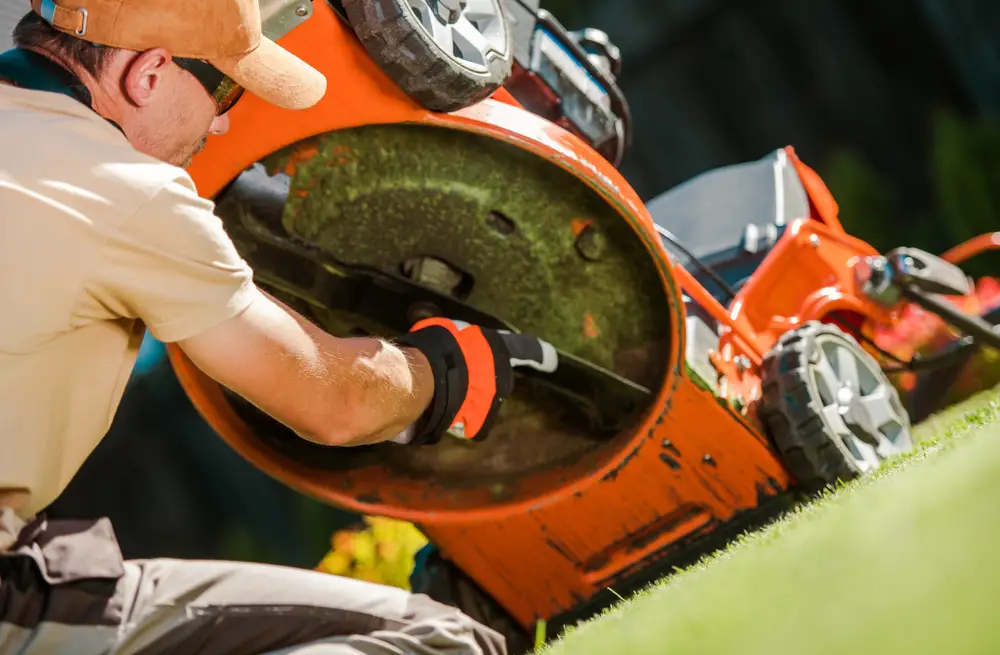
Cracked, bent, or broken blades cause your lawn mower to rattle when they’re running. Everything under the deck is supposed to remain balanced, and if the blades suffer from one of these issues, it causes them to strike the deck or the ground if the deck is too low.
This issue, as with many problems, requires immediate attention, especially if the blades are loose.
What To Do
Inspect the blades when your lawn mower is off. Replace them if you notice they are warped, broken, or cracked. Loosen and remove the fastening nut or bolt, securing the blade using a wrench or socket set, then fasten the new blade.
Bring your lawn mower to the shop if you notice the broken blades damaged the deck. Situations like these may require welding or reshaping the deck, requiring certified welders.
2 – Engine Mount Issues
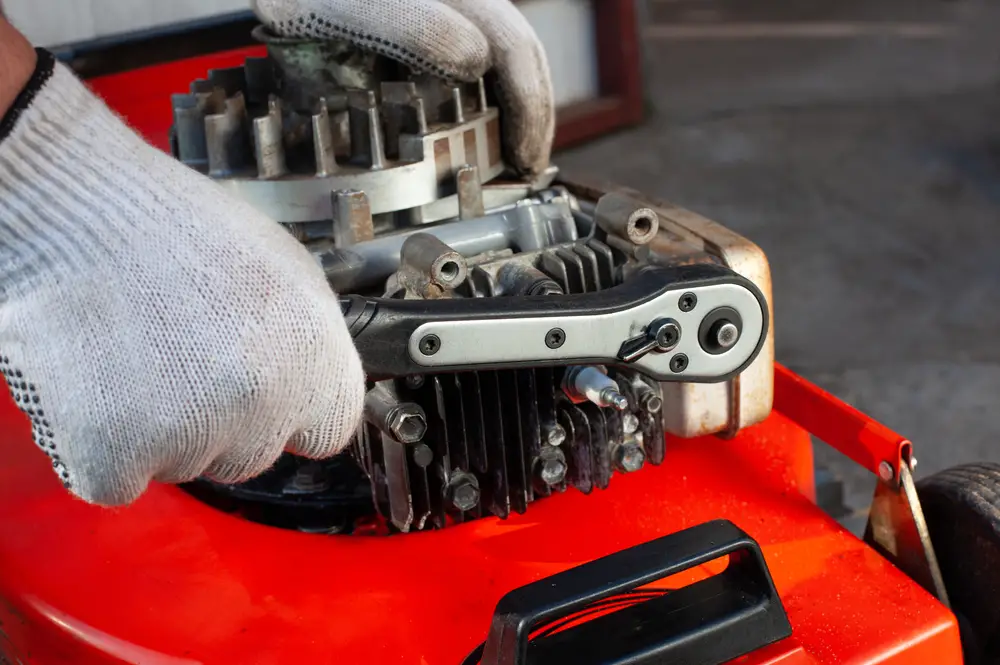
Your lawn mower’s engine operates with a lot of power, so it needs a strong, reliable mount. A poorly mounted engine or loose mount can cause shaking and rattling. You can locate your lawn mower’s engine mount underneath the motor, attached to the chassis or metal frame.
What To Do
Leave this to certified small-engine mechanics. They have the proper tools and knowledge to support the engine while working or replacing the engine mount. They will also know what to look for while everything is taken apart to see if there is damage to the chassis, frame, or bushings, and they will replace them as needed. If the engine mount is bad, other parts will likely need this additional inspection.
3 – Bent Crankshaft
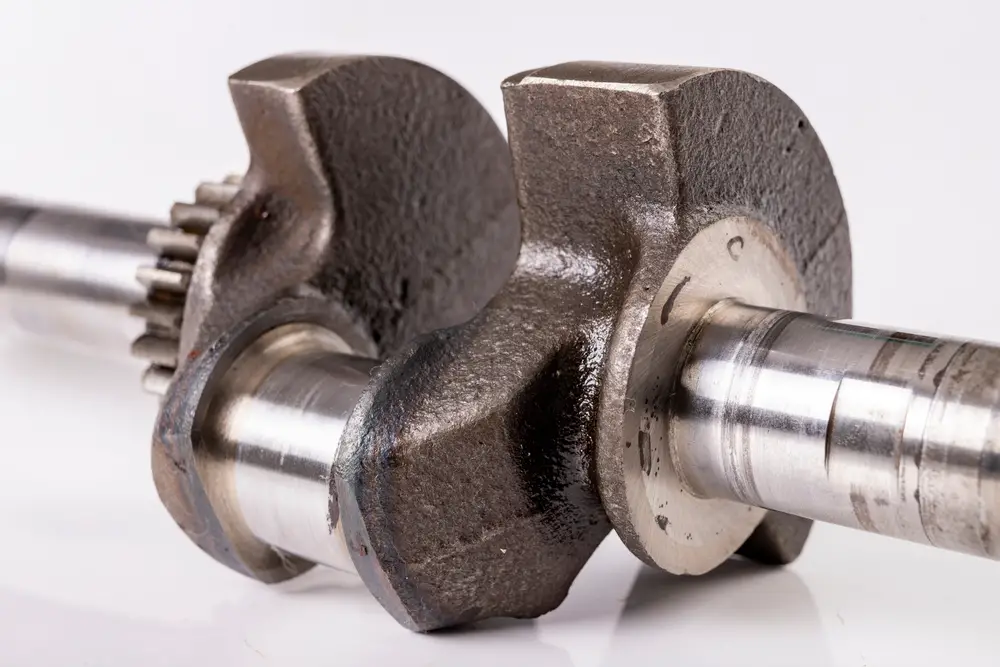
The crankshaft is part of the internal combustion within engines. It rotates with the pistons to power the engine’s inner parts, keeping everything in motion. The crankshaft also powers the lawn mower’s cutting blades and other functions.
A bent crankshaft loses its balanced rotation, causing irregular and uneven movement. This imbalance results in noticeable vibrations, increased engine noise (rattling), reduced engine performance, and ultimately ruins the lawn mower. A bent crankshaft leads to improper timing, affecting combustion and potentially damaging other engine components over time.
What To Do
This is another issue for a professional to handle. Fixing or replacing a crankshaft requires specialized knowledge and tools.
4 – Debris And Dirt Build-Up
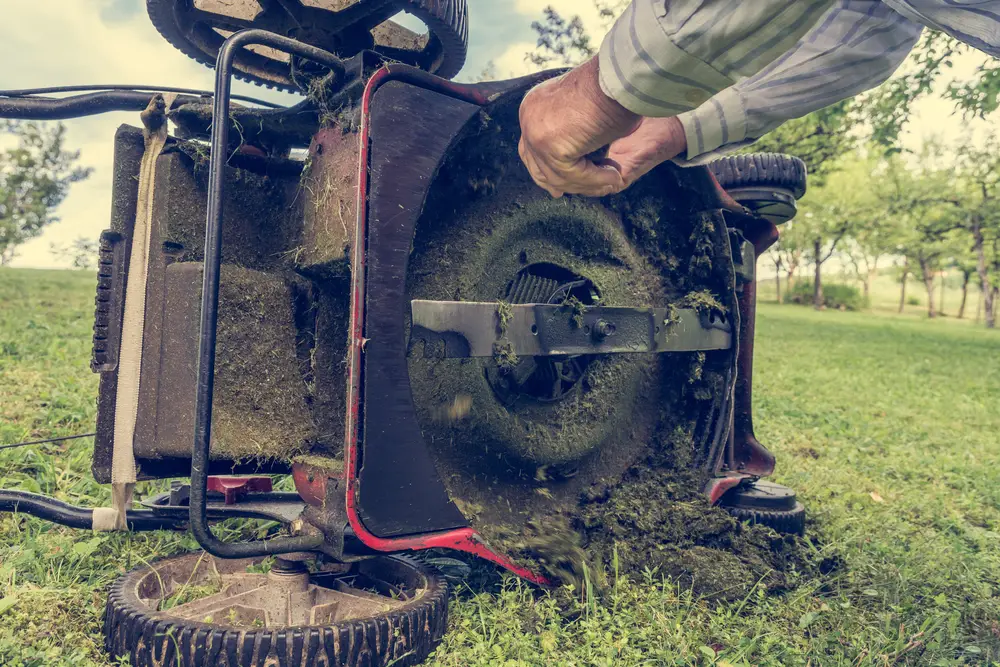
Debris and dirt build-up becomes a problem anywhere they occur on your lawn mower. If enough of one builds up, it can cause some moving components, like the blades or pulleys, to work up against the debris, causing a rattling noise.
What To Do
Washing your lawn mower or using a blower to remove dirt and debris is an easy fix. However, if the build-up is under or on top of the deck, you may need to use a scraper to remove excess build-up of dirt.
In some cases, long-ignored dirt build-up can become concrete hard. You’ll need a hammer and chisel to chip away at it (carefully so you avoid damaging your lawn mower).
5 – Damaged Or Loose Belts
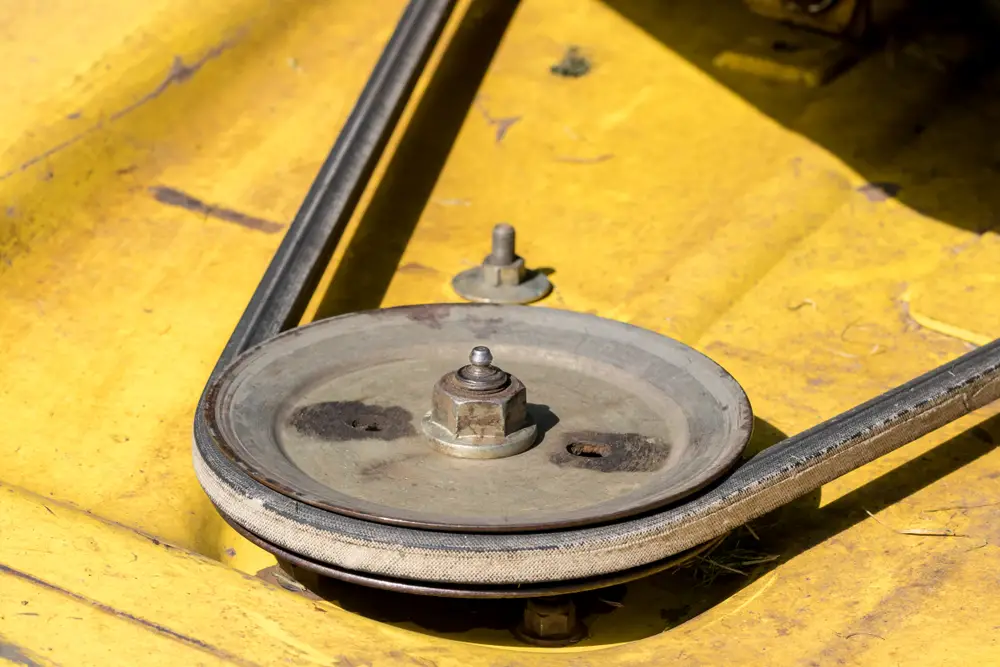
Belts stretch and become loose over time. This causes vibrations or a rattling noise underneath your lawn mower. The belts could also slip off the pulleys or break over time.
Worn belts also prevent your lawn mower’s blades from operating at their best. This issue could also cause a rattling noise underneath your lawn mower’s deck.
What To Do
First, inspect the belt to see if it needs replacement or an adjustment. A damaged belt needs replacing, while a loose belt needs tightening.
Your lawn mower and owner’s manual should include a diagram for putting belts around the lawn mower’s pulleys.
Tighten A Loose Belt
To tighten a belt, locate the belt tension adjustment bar. Loosen the fasteners, securing the bar on each side. Then, either slide the bar to increase the tension or adjust the position of the idler pulley (the pulley will move with the bar).
Gradually tighten the fasteners while maintaining the desired tension. Check the belt’s deflection (the amount it will be pushed down) to ensure it’s within your owner manual’s recommendations. Avoid overtightening, as this strains components and leads to premature belt wear.
Replace A Damaged Belt
Remove the belt from around the pulleys if it isn’t already. Place the new belt over all the pulleys except the last one around the tension bar. Lessen the tension, slide the belt on, and release the tension bar slowly. This will set the belt in place.
6 – Loose Handles Or Controls
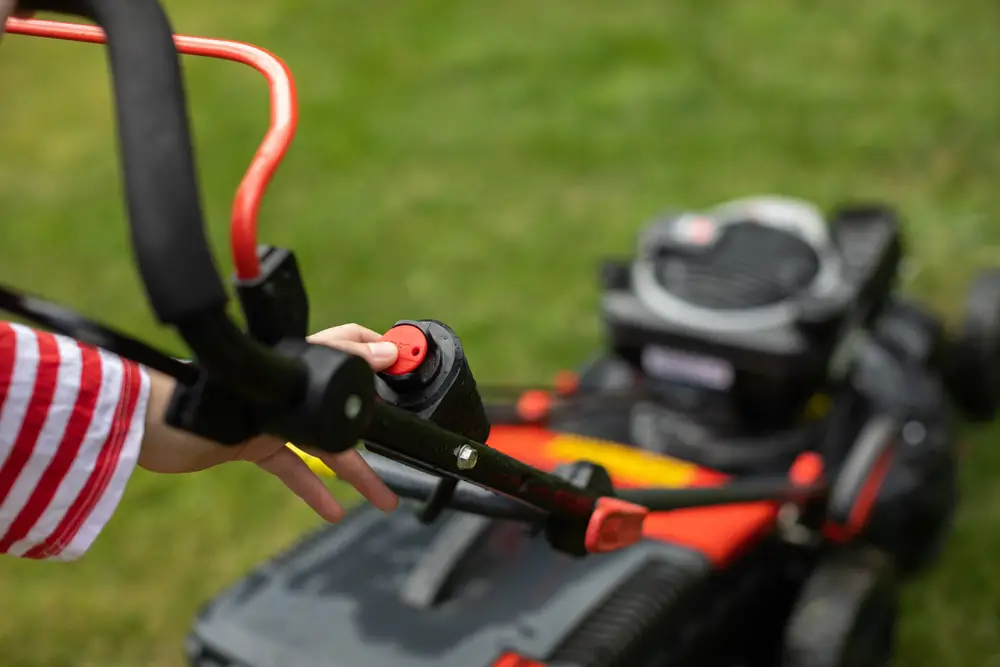
Any loose component will rattle when your lawn mower is running. Handles or controls are no exception.
Loose handles or controls can also cause further issues than rattling, such as not allowing full operation or control of your lawn mower.
What To Do
You can adjust most handles or controls from behind their face plates (directly behind the labeled control area. Example: The throttle has a symbol of a rabbit/turtle, while a deck lever will have the plate showing numbers for the deck height). Look for screws, bolts, or other items holding the face plates down. Remove them to get behind them, where you’ll often see screws.
Turn these screws to tighten the handle or control in place. Return the faceplates and tighten what was holding them there.
7 – Fuel System Problems
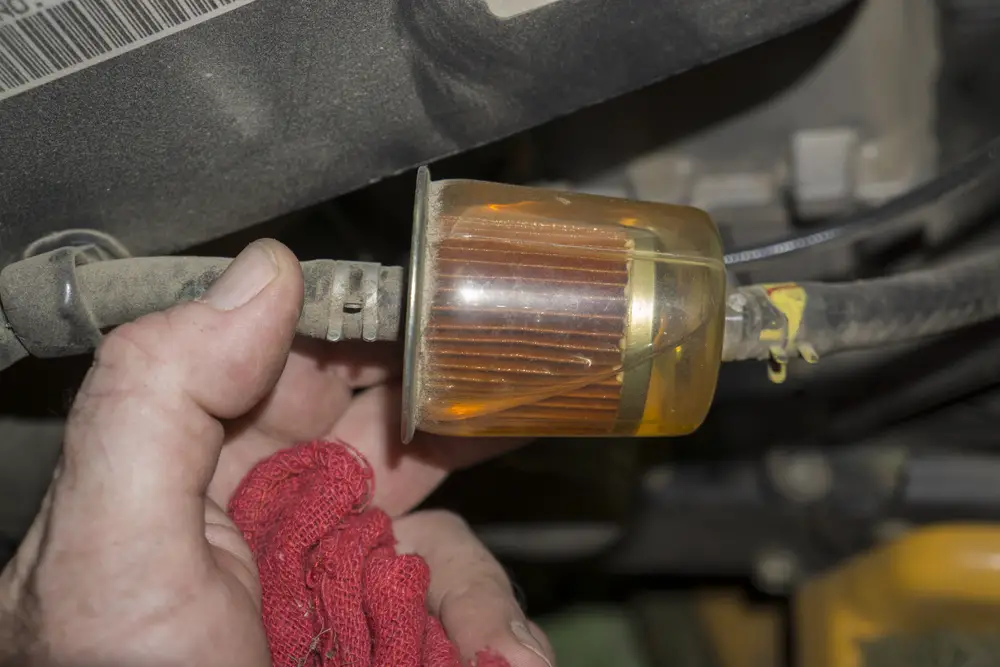
Fuel system problems in a lawn mower will lead to rattling noises due to their impact on engine performance and combustion. If the fuel system isn’t delivering the proper amount of fuel to the engine, it leads to misfiring or incomplete combustion. This will result in irregular engine firing patterns, causing vibrations and rattling throughout the lawn mower as the engine struggles to run smoothly.
What To Do
You have three options for fuel system issues. Try these in order to see if the problem is repairable. If one option doesn’t work, move to the next.
Option one is using fuel treatment.
Option two is cleaning various fuel system components, such as your lawn mower’s fuel lines, fuel tank, fuel pump, and fuel filter (which you could also replace).
Option three is to take your lawn mower to the shop.
8 – Faulty Bearings And Bushings
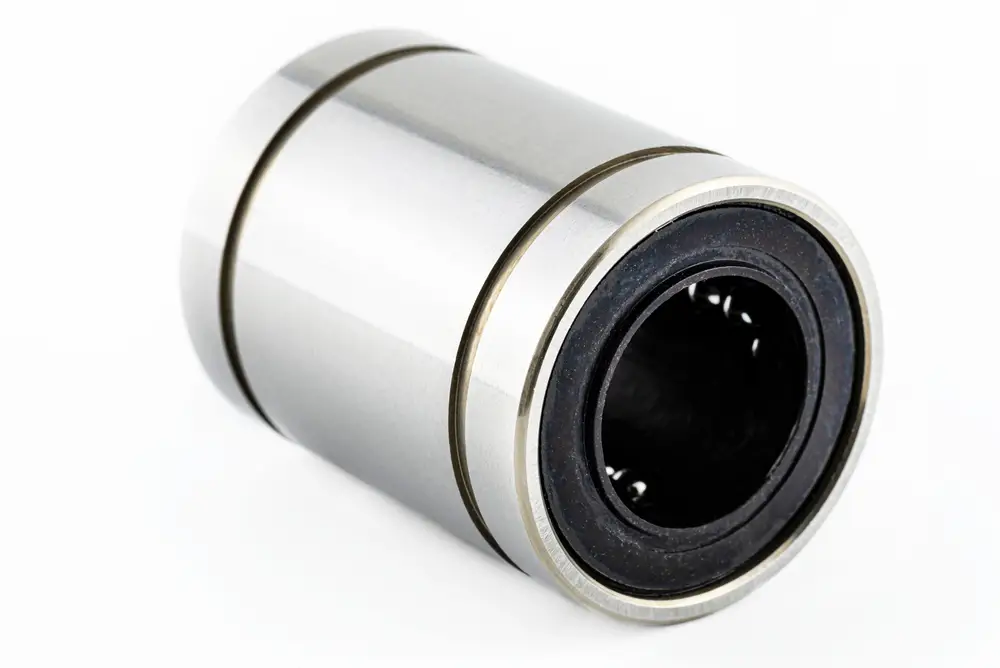
Worn or damaged bearings and bushings can cause a range of issues that manifest as rattling noises. These include:
- Increasing friction between parts
- Reduced part stability, leading to uneven rotations or wobbling
- Increased engine vibrations, which can cause vibrations and rattling in other components
What To Do
Follow your owner’s manual for proper bearing and bushing lubrication. You cannot grease some bearings since they are sealed. Others have grease zerks (small stems on the side where the grease gun connects by pushing it straight onto the stem).
You’ll need to deliver two to three squirts from your grease gun every two to three weeks (depending on how often you use your lawn mower).
However, eventually, your lawn mower’s bearings and bushings will fail. Bring your lawn mower to the professionals when this happens. Too many things can go wrong when replacing these, while you must press bearings, a job best left to the professionals.
9 – Unbalanced Cutting Deck
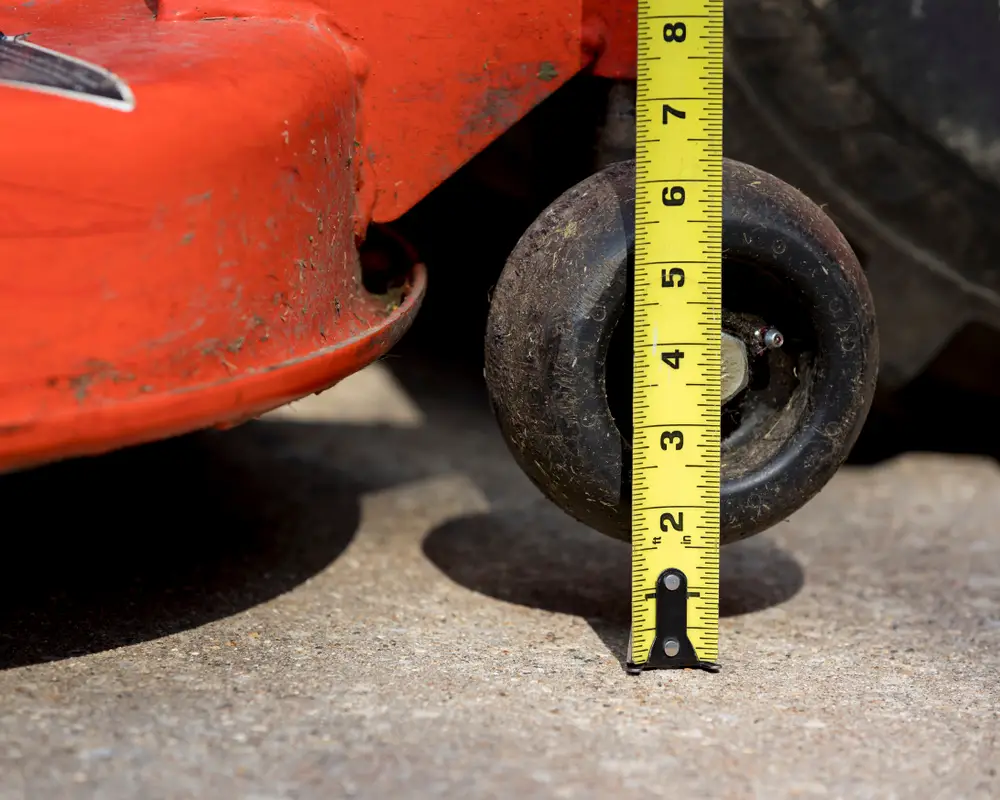
An unbalanced cutting deck causes your lawn mower’s blades to rotate unevenly, creating erratic forces resonating throughout the lawn mower’s chassis. These vibrations show up as rattling noises as your lawn mower struggles to maintain a smooth and stable cut.
This also causes an uneven cut as you mow your grass.
What To Do
Regular deck leveling and maintenance are essential to ensure even weight distribution and minimize rattling and vibrations during mowing.
All lawn mowers and decks differ. Review your owner’s manual for how to level your lawn mower’s deck. Keep in mind you’ll need a level surface to do this on. Otherwise, you’ll need to take it to the professionals.
10 – Poor Maintenance Practices
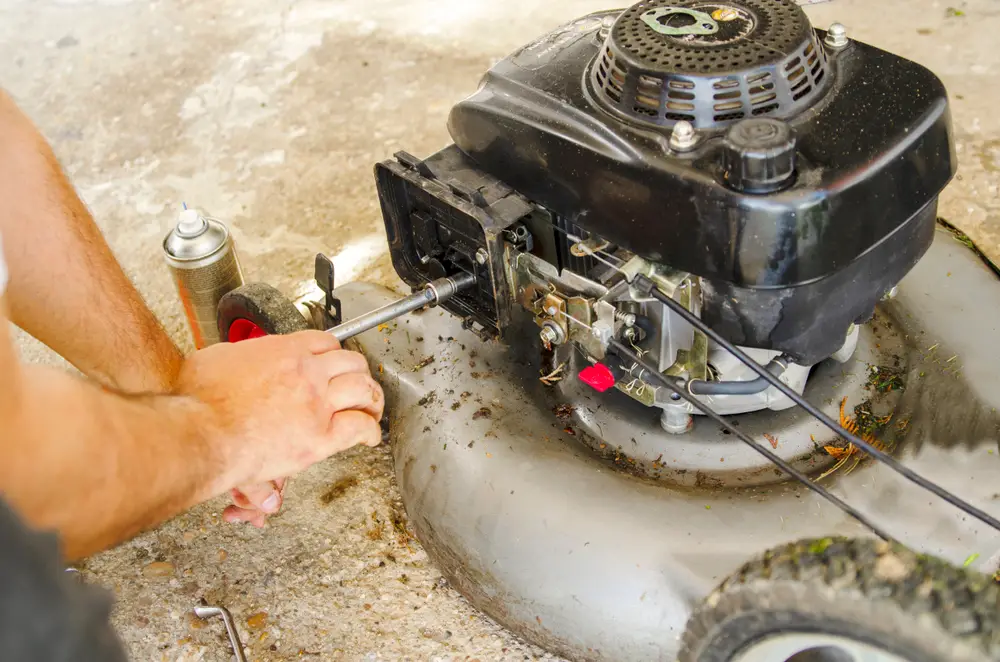
Neglected maintenance leads to loose or worn components, such as bolts, fasteners, and belts, which causes parts to vibrate and create rattling noises while your lawn mower is running.
Lack of maintenance also increases friction, causing parts to wear out faster and generating vibrations contributing to the overall rattling noise.
What To Do
Create an organized, thorough, and consistent schedule for your lawn mower maintenance. Stick to your plan and document everything.
Your owner’s manual will have some ideas for essential maintenance, but generally you’ll want to:
- Sharpen the blades every 20 to 25 hours of use
- Maintain a balanced cutting deck
- Keep your air filter clean and change it once a year
- Keep your fuel clean
- Maintain a proper oil level and fresh oil
- Make sure all nuts, bolts, and other fasteners are tight
Also, make it a habit to check your lawn mower before and after each mowing session.
Personal Experiences With A Rattling Lawn Mower
One of the worst places to have the rattling noises occur is around your lawn mower’s deck since the blades turn so fast. Once, this issue affected my lawn mower’s bearings and pulley. Because the pulley went bad, it shredded the belts and bent one of the two blades on my lawn mower. When I looked closer, I realized the deck had a two-inch gash from the blade.
Sometimes, there is no warning when parts fail like this. Bearings are one of those parts, leaving you little time to prepare. It’s too late once you hear the rattling, but don’t be too hard on yourself. Maintenance is essential, but it can’t prevent everything.
When you hear a rattling noise, give it your full attention. Hopefully, it’s nothing like my experience, but brace yourself just in case.
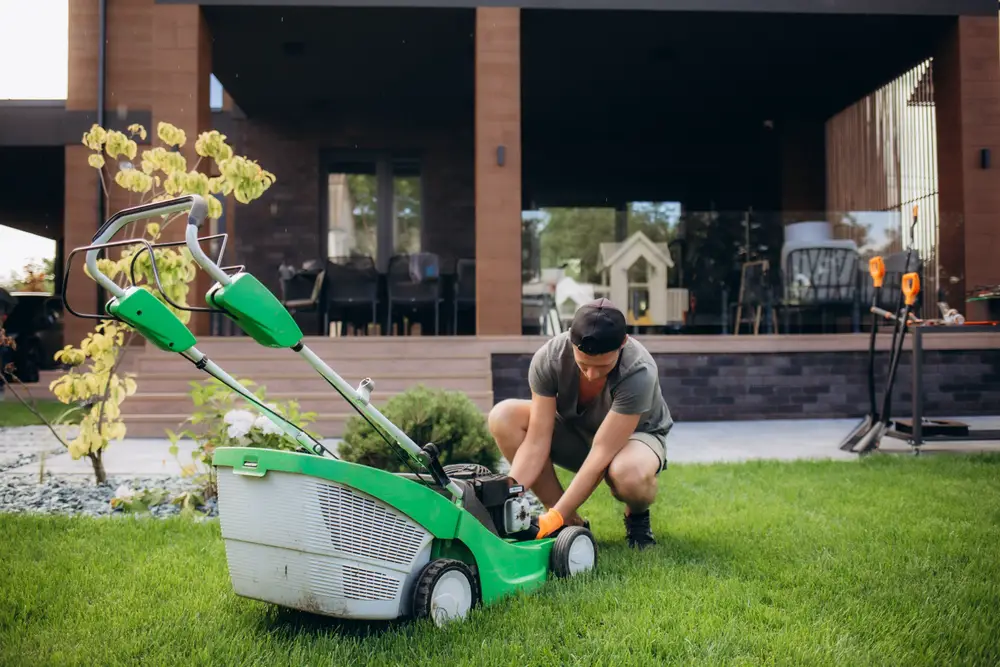
That is not the “drive belt”.
That is the “mower deck drive belt”.
The “drive belt” is the one that strangely enough
DRIVES the tractor.
Wrong belt! That is the deck belt! I thought I had finally found a site to assist me in changing my DRIVE BELT but I was mistaking! Again, this is NOT the drive belt it’s the deck belt…